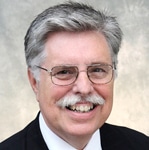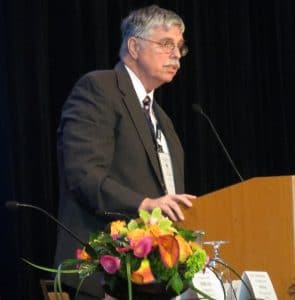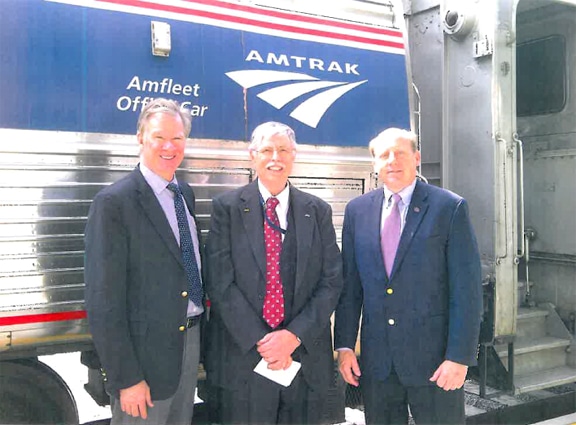Amtrak announced today that former President and CEO Joseph Boardman, 70, died today after having a stroke March 5:
“We are deeply saddened to learn of the passing of Joe Boardman.”
“Joe, during his tenure as FRA administrator, Amtrak board member and Amtrak president & CEO, was a tireless advocate for passenger rail and the nation’s mobility. During his eight years at the helm, Joe helped the company make significant progress in reducing our debt, improving our infrastructure and raising our cost recovery performance.”
“He leaves a lasting legacy that includes public service and making passenger rail transportation better for millions of people.”
Click here to read tributes from Trains Magazine and Railway Age.
Relatives and friends may call at the Barry Funeral Home, 807 W. Chestnut St., Rome, NY 13440 on Thursday, March 14 from 2 to 4 p.m. and from 6 to 8 p.m. A Mass of Christian Burial will take place at 11 a.m. on Friday, March 15 at St. Paul’s Church, 1807 Bedford St., Rome, NY 13440. Interment will be at St. Patrick’s Cemetery, Route 285, Taberg, NY 13471 and will take place in the spring.
In lieu of flowers, contributions may be made in Boardman’s memory to Unity Acres, 2290 County Route 2, P.O. Box 153, Orwell, NY 13426; Health Friends, 1119 Elm St., Utica, NY 13501; or to the Epilepsy Foundation.
To read Boardman’s official obituary or to leave condolences, click here.
Tag: Joseph Boardman
ST. PAUL, Minn. – Amtrak inaugurated service to Union Depot in St. Paul May 7, effective with the arrival of the Empire Builder from Chicago. Amtrak President and CEO Joe Boardman was among several transportation leaders who cut the ribbon for the first-ever Amtrak service in Downtown St. Paul.
Officials with Ramsey County Regional Railroad Authority (RCRRA), owners of Union Depot, welcomed federal, state and local officials – and the general public – to the station in St. Paul’s Lowertown, with the ticket office at Union Depot’s Kellogg Entry at 240 Kellogg Blvd., E.
SMART Transportation Division Minnesota State Legislative Director Phillip Qualy was also in attendance to greet Boardman and attend the ribbon-cutting ceremony.
“The SMART Transportation Division, formerly the UTU, continues to work as a member of the Minnesota DOT’s passenger rail office in support of Amtrak’s Twin Cities-Chicago additional train frequencies, an Amtrak extension to St. Cloud, the Rochester Zip Line, Duluth NLX and with advocacy for regional services,” Qualy said.
“As a reminder , in 2013, UTU/SMART was chief advocate for legislation passed into law that provided Minnesota’s DOT with authority to contract with Amtrak and assures any new-start passenger or commuter rail service will be operated with train crew’s covered under the Railway Labor Act, FELA, FRSA, and U.S. Railroad Retirement Board rights preserved and in place.”
The Amtrak schedule is slightly different at Union Depot from those at that the former Midway Station between St. Paul and Minneapolis, which no longer has any public functions. The westbound Empire Builder (Train 7/27) arrives at 10:10 p.m. and the eastbound Empire Builder (Train 8/28) arrives at 8:00 a.m.
At Union Depot, Amtrak travelers can connect from more than 500 destinations to intercity buses, Metro Transit and MVTA bus services. Next month, Metro Transit’s Green Line will provide additional capacity to a growing and diverse regional transportation system.
“We know from experience that travel brings business – and that stations bring business to the surrounding community,” Boardman said. “While we’re celebrating the fact that today the people of the Twin Cities will now have more travel choices than ever before, we can also celebrate the fact that they have a station that’s also an engine – an engine of economic development for the surrounding neighborhood and historic district.”
“With Amtrak, the range of transportation options at Union Depot expands opportunities for travel connections throughout the Upper Midwest and beyond. Our beautifully restored building is achieving our vision as a multimodal transit facility and a unique gathering place for people – whether they are travelers passing through, living in St. Paul, stopping in the area for business, or here to attend one of many social or cultural events this region has to offer,” said Ramsey County Commissioner Rafael Ortega, chair, RCRRA.
Funding for the $243 million project was obtained from a diverse mix of federal, state and local agencies. One of the largest grants was $45.3 million allocated under Section 1301 of SAFETEA-LU, the federal transportation bill for fiscal years 2005-2009. These funds were specifically distributed to large-scale projects of national or regional significance. In early 2010, the RCRRA was awarded a $35 million Transportation Investment Generating Economic Recovery (TIGER) grant by the U.S. Department of Transportation. Forty million dollars came through the Federal Railroad Administration’s High Speed Intercity Passenger Rail Program, while $4 million from the Federal Transit Administration’s (FTA) Bus and Bus Facilities Program helped finance the new bus terminal. Other funds used in the project were obtained from state bonds and a tax levy imposed by the RCRRA.
“In addition to improving transportation, this project has created more than 4,000 jobs and has led to a surge in housing and retail development in St. Paul,” said Karen Hedlund, Deputy Administrator, Federal Railroad Administration. “This is what we can achieve — in Minnesota and nationwide — if we continue investing in passenger rail.”
“It’s a great day to welcome passenger rail back to Saint Paul, and no better place to do it than the historic Union Depot—a building that would have met the wrecking ball if not for the leadership of its many champions from the County Board to the White House,” said St. Paul Mayor Chris Coleman. “The Amtrak opening today and the Green Line opening in just a few weeks is proof that transportation investments are critical to economic growth and regional prosperity.
“We thank the President and Transportation Secretary Foxx for their continuing commitment to improving our roads, bridges and rail systems, and we look forward to helping them pass the next major transportation bill.”
Amtrak will soon deliver a report to the Minnesota Department of Transportation (MnDOT) regarding an additional round-trip on the Empire Builder’s route between St. Paul and Chicago, one of four passenger rail corridors being considered by the state.
“MnDOT is committed to be multimodal and to pursue a multimodal vision,” said state transportation commissioner Charles Zelle. “We will develop a robust intrastate and interstate passenger rail system in Minnesota.”
Amtrak notified previously booked passengers of the change in service locations in St. Paul prior to this morning’s event, which was attended by more than 200 people. The celebration continues through this Saturday, May 10, with Union Depot hosting a National Train Day event.
SMART Transportation Division Minnesota State Legislative Phillip Qualy, right, meets Amtrak President and CEO Joseph Boardman, center, and St. Paul Mayor Chris Coleman May 7 at the St. Paul’s Union Depot.

“There is insufficient NEC infrastructure investment to meet both the on-going normalized replacement and the backlog capital requirements. And that means we are eating our assets alive,” he explained.
Boardman said this de-capitalization of NEC assets leads to rapidly increasing degradation of ride quality, reliability, and the ability to support major improvement projects.
He urged the federal government to act now and use the opportunity of rail reauthorization legislation to take the lead in funding a major program to build out the NEC infrastructure needed for the coming century. Amtrak shares the NEC with eight commuter railroads and its infrastructure supports the movement of 260 million intercity and commuter rail passengers each year. Several of the most important segments, such as the New York tunnels, are at capacity with ridership demand at record levels and growing.
Boardman noted Amtrak needs $782 million every year for the next 15 years just for the costs of NEC normalized replacement ($386 million) and the backlog of infrastructure work ($396 million). That level of funding will allow Amtrak to run a safe railroad at maximum allowed track speed, maintain an excellent on-time performance and meet the basic needs of those who want to develop real estate along the NEC and fill their development with the people who they expect to come by train. However, it will not address needed capacity improvements, trip-time reductions or other new initiatives.
He reminded committee members that after Amtrak was given control of the NEC in 1976 during the Conrail process, it was followed by several significant, federally-funded repair and improvement programs which transformed the dilapidated mid-century rail operation it inherited into the successful high-rail speed rail route it is today.
A copy of Boardman’s full written testimony can be found here.

“We are extremely pleased with the progress Amtrak has made under the leadership of Joe Boardman,” said Chairman Tony Coscia. “The changes Joe is managing within the railroad are resulting in real accomplishments and it is important for him to stay on, continue his work and provide leadership for the challenges and opportunities that lie ahead.”
At its May meeting, the Amtrak board of directors approved a two-year renewable contract for Boardman, who was appointed president and CEO in November 2008.

“As a result of the good work Amtrak employees across the company are doing to implement our plans and produce our achievements, the board of directors asked me to continue in my role,” said Boardman. “Key to our current success is our improved financial position and our plans for growth are made more attainable because Amtrak is covering more of its operating costs, and costs are under control and in line with industry standards.”
Under Boardman’s leadership, Amtrak has experienced many accomplishments including record ridership and revenue, continued reductions in the need for federal operating support, a significant reduction of debt, the best ever system-wide on-time performance, expansion of state-supported services, the introduction of Wi-Fi service and eTicketing, and the creation and implementation of a corporate strategic plan.
In addition, he is managing new equipment orders for Northeast Corridor (NEC) and long distance services, a major planning effort for the development of next-generation high-speed rail, a comprehensive employee safety program, enhanced security initiatives and numerous capital projects to improve Amtrak infrastructure, stations, maintenance shops and other facilities.
On his first day at Amtrak during the 2008 Thanksgiving holiday travel period, Boardman walked the platforms at Washington Union Station, greeting passengers and talking with employees and has continued that practice whenever and wherever he travels. It is not uncommon to see him speaking to passengers aboard a train or visiting with employees out on the railroad at crew bases, rail yards, stations and other locations. He has logged over 200,000 miles traveling on Amtrak trains during his tenure.
Joseph H. Boardman was appointed president and chief executive officer of Amtrak by its board of directors in November 2008. Under his leadership, Amtrak has improved its operating and financial performance, and is building the equipment, infrastructure and organization needed to ensure its strong growth continues. The company is investing in projects critical for enhancing the passenger experience and essential for supporting its national network of intercity and high-speed rail services. In addition, Amtrak’s next-generation high-speed rail vision will provide a global competitive advantage for the United States.
Before joining Amtrak, Boardman was the administrator of the Federal Railroad Administration (FRA), an agency under the U.S. Department of Transportation, and also served as a member of the Amtrak Board of Directors. Prior to his position at FRA, he was the longest serving commissioner of the New York State Department of Transportation.

Fifteen states currently provide Amtrak with subsidies in exchange for Amtrak operating additional intercity trains in their states that transport nine million passengers annually.
The Sept. 8 budget proposal would prohibit federal funds from being used for those state-supported trains.
While the Amtrak budget cuts – proposed by the House Transportation Appropriations Subcommittee — could likely pass the entire Republican-controlled Appropriations Committee and Republican-controlled House of Representatives, the provisions could face strong opposition in the Senate. Still, given the budget-cutting pressure in Congress, nothing is easily predicted.
The proposed budget cuts fly in the fact of a provision of the Passenger Rail Investment and Improvement Act of 2008 that encouraged Amtrak to leverage federal subsidies of 80 percent with state contributions of 20 percent to develop new intercity passenger routes and improve existing ones.
The Transportation Appropriations Subcommittee’s budget proposal would also:
* Restrict the use of federal funds for any overtime costs in excess of $35,000 for any individual employee.
* Require Amtrak to achieve savings through operating efficiencies, including modifications to food and beverage service, first-class service and long-distance routes.
“The House Republican plan is shortsighted and is the wrong policy for America,” said Amtrak President Joseph Boardman. “It will result in the loss of jobs and reverses significant progress made to use passenger rail to reduce U.S. dependence on foreign oil.”
Following are the 15 states — and the Amtrak trains — targeted:
* California: (Capitol Corridor, San Jose-Oakland/San Francisco-Sacramento/Auburn); Pacific Surfliner (San Luis Obispo-Los Angeles-San Diego); San Joaquin (Bakersfield-Oakland-Sacramento).
* Illinois and Wisconsin: (Hiawatha, Chicago-Milwaukee). Illinois: Lincoln (Chicago-St. Louis); Illini & Saluki (Chicago-Carbondale); Zephyr & Carl Sanburg (Chicago-Quincy).
* Maine: (Downeaster, Portland-Boston).
* Michigan: (Blue Water, Port Hurton-East Lansing-Chicago); Pere Marquette (Grand Rapids-Chicago).
* Missouri: Missouri River Runner (Kansas City-St. Louis).
* New York: Adirondack (New York City-Montreal).
* North Carolina: Carolinian (Charlotte-New York City); Piedmont (Charlotte-Raleigh).
* Oklahoma and Texas: Heartland Flyer (Oklahoma City-Ft. Worth).
* Oregon and Washington: Cascades (Eugene-Portland-Seattle-Vancouver).
* Pennsylvania: Keystone Corridor (Harrisburg-Philadelphia-New York City).
* Vermont: Ethan Allen (Rutland-New York City); Vermonter (St. Albans-Washington, D.C.).
* Virginia: (Extended Northeast Regional (Washington, D.C.-Richmond; Washington, D.C.-Lynchburg).
WILMINGTON, Del. — Amtrak CEO Joseph Boardman, FRA Administrator Joseph Szabo and former BNSF top attorney Jeff Moreland, now an Amtrak board member, were enroute here from Washington Saturday morning for dedication of the new station renamed for Vice President Joe Biden.
They got as far as Baltimore on their first-class passes.
A power problem on the Northeast Corridor stopped all Amtrak trains dependent on the overhead catenary for power.
Fearful they would miss the dedication, they made a call and soon left the train, piling into an automobile quickly provided, and reached Wilmington only a bit late. Biden was patiently awaiting them.
“We would not have gotten off the train if we could have sequenced it faster, but the event would have been over … and that’s the evaluation we made,” Boardman told ABC News.
The news dispatch reported they “were escorted from the coach by security guards and a small entourage of assistants.” ABC News said rental cars were obtained for the entourage.
Biden understood. He said later he had taken more than 7,000 roundtrips between his home in Wilmington and Washington while a U.S. senator; and, yes, not all were on time.
The remaining passengers on the train endured a two-and-a-half hour delay, later attributed to a malfunctioning transformer in Philadelphia.
Boardman used the opportunity to make a pitch for more federal funds for the Northeast Corridor. “If we’re going to really grow the Corridor the way it needs to be grown, we have to substantially increase the amount of power that’s available so that we don’t trip these transformers,” he told ABC News.

